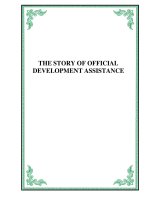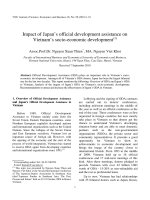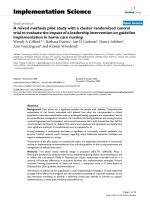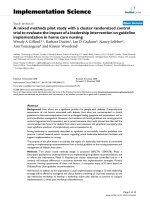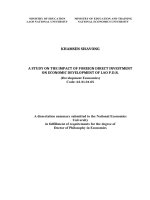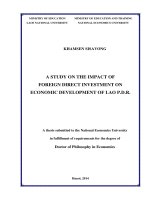Thesis summary: The impacts of official development assistance on economic growth in developing countries
Bạn đang xem bản rút gọn của tài liệu. Xem và tải ngay bản đầy đủ của tài liệu tại đây (737.34 KB, 41 trang )
MINISTRY OF EDUCATION AND TRAINING STATE BANK OF VIETNAM
BANKING UNIVERSITY HO CHI MINH
*****
VU DUC BINH
THE IMPACTS OF OFFICIAL DEVELOPMENT ASSISTANCE
ON ECONOMIC GROWTH IN DEVELOPING COUNTRIES
Major: Finance - Banking
Code: 9.34.02.01
THESIS SUMMARY
HO CHI MINH CITY – 2019
MINISTRY OF EDUCATION AND TRAINING
STATE BANK OF VIETNAM
BANKING UNIVERSITY HO CHI MINH
*****
VU DUC BINH
THE IMPACTS OF OFFICIAL DEVELOPMENT ASSISTANCE
ON ECONOMIC GROWTH IN DEVELOPING COUNTRIES
Major: Finance – Banking
Code: 9.34.02.01
THESIS SUMMARY
ACADEMIC ADVISOR
ASSOCIATE PROFESSOR., PHD. DANG VAN DAN
HO CHI MINH CITY – 2019
INTRODUCTION
1. The necessity of the study
Practical researchs in many countries receiving ODA in the world shows that
ODA capital is not always effective. Sometimes, ODA capital negatively impacts
economic growth or negative impact reduces the national economy. For example,
the scale of public debt increases rapidly, the nation's debt repayment burden
increased, there may be risks associated with fluctuations in interest rates and
exchange rates, official development assistance does not contribute to economic
growth when this capital is put into investment but ineffective, rampant and
wasteful investment, problems of corruption, group benefits… An Official
development assistance may has a positive or negative impact on economic growth
in the country receiving this capital. This shows the significance of the need for a
clear thorough study of the impact of official development assistance on economic
growth.
2. Objectives of the study
The overall objective of the thesis is to assess the impact of official
development assistance on economic growth in developing countries. Besides,
considering how ODA affects economic growth in terms of public administration
quality, capital absorption and corruption management quality of developing
countries. On the basis of the thesis findings, a thesis will provide an appropriate
solution for this capital source, contributing to the economic growth in developing
countries, including Vietnam.
3. Scope of the study
The thesis studies the impact of official development assistance capital on
economic growth. The scope of the thesis research for 68 developing countries with
the study period is 21 years from 1996 to 2016.
4. Methodology of the study
In order to achieve the objectives of the study, the main research methods
used methods of econometric analysis.
The author used classical linear estimation methods of panel data model such
as Pooled OLS, Fixed effect (FEM) and Random effect (REM). The thesis uses the
method of moment 2-step (SGMM two-step) because this method handles some
defects of the model such as: self-correlation, heteroscedasticity and endogenous.
5. Scientific and practical significance of the thesis
Scientific significance: currently, assessing the impact of official
development assistance on economic growth is still a controversial issue. Especially
in Vietnam, the previous studies related to the topic of official development
assistance only used qualitative analysis studies. Therefore, this research direction
contributes in terms of scientific significance to the field of research on this topic.
The results of quantitative analysis and empirical evaluation of the thesis will
contribute to scholarly research for a specific developing country like Vietnam and
other developing countries in the world.
Practical significance: the results of empirical analysis and evaluation of the
thesis are used to make more basic recommendations, provide important evidence to
help policy makers and government regulators. The state in developing countries
has an orientation to regulate suitable macro policies for this source of capital to
ensure the goal of actively supporting economic growth, creating more jobs and
improving living standards. spiritual qualities of people, stability and socioeconomic development. In addition, the thesis's completion of this research topic
also contributes to forming the research foundation for further studies for Vietnam
alone and create a more scientific perspective in making strategic decisions for
official development assistance.
CHAPTER 1: OVERVIEW OF RESEARCH AND THEOREOTICAL BASIS
ABOUT THE IMPACTS OF OFFICIAL DEVELOPMENT ASSISTANCE
ON ECONOMIC GROWTH
1.1 Theoreotical basis about official development assistance
1.1.1 Theories about official development assistance capital
According to the Organization for Economic Cooperation and Development
(OECD), the concept of ODA is given as follows: “ODA is the official transfer of
support established with the main purpose of promoting socio-economic
development of developing countries. The financial condition of this transfer of
support is of a preferential nature and the non-refundable element is at least 25%”
(OECD, 1991). According to the World Bank, the definition of ODA is as follows:
“ODA is part of the official development financing (ODF), which includes nonrefundable aid plus preferential loans accounting for at least 25% of total aid, called
ODA. Official Development Finance (ODF) is all the financial resources developed
by governments of developed countries and multilateral organizations for
developing countries” (WB, 1999).
1.1.2 Classification of official development assistance
Under according to the nature of capital supply of the official development
assistance capital, there are 3 types: non-refundable ODA capital, preferential ODA
loan capital and ODA capital from mixed loans.Under sponsors provide official
development assistance, there are 2 types: bilateral ODA and multilateral ODA.
Under the terms and conditions of official development assistance, there are two
types: non-binding ODA and binding ODA. In the form of providing official
development assistance, there are 7 types: relief and emergency aid, food assistance,
independent technical cooperation, budget support, bar balance support. math,
project support and non-project support.
1.2 Theoreotical basis about economic growth
1.2.1 Theories about economic growth
According to Simon Kuznets (1959), economic growth is a long-term
increase in per capita output or output per worker. According to Douglass C.North
and Robert Paul Thomas (1973), economic growth only occurs if output grows
faster than the population. According to Adam Smith (1923-1970): labor is a source
of social value and is considered a decisive factor for economic growth. According
to David Ricardo (1772-1823): agriculture is the most important economic sector,
the basic elements of economic growth are land, labor and capital. Meanwhile,
according to the World Bank (WB), the definition of economic growth is: the
change or expansion in quantity in the economy of a country. Economic growth is
often measured by the growth rate of gross domestic product (GDP) or gross
national product (GNP) in a year. Economic growth has two forms: firstly, growth
in width by using more resources such as material, labor, natural capital; The
second is deep growth using more efficient resources.
1.3 Theories about the impact of official development assistance on economic
growth
1.3.1 Harrod-Domar model
This model shows the relationship between output growth and investment
demand, which emphasizes the investment rate needed to achieve a target growth
rate and is described by the formula: g = (s / k). In which: g is the rate of output
increase (∆Y / Y), s is the saving rate, k is the increase rate between capital - output
output (also called Icor coefficient (The Incremental Capital - Output Ratio) means
that to achieve 1 unit of increased output, how much additional investment capital is
needed: ∆K / ∆Y). The model Harrod-Domar focuses on the role of savings and
capital for economic growth. Therefore, economies need to increase savings,
increase investment and reduce Icor coefficients to boost economic growth. The
Harrod-Domar model allows countries to estimate the domestic savings rate (or
investment level) corresponding to a targeted economic growth rate. Increasing
domestic savings or reducing the Icor coefficient (reducing the capital-output
correlation) all shortened the gap between the demand for capital and the capital
supply of the economy to achieve the expected growth. However, both are not easy
to implement in the short term, especially for poor countries. Therefore, other
declaration of foreign capital flows is paid attention in practice through foreign
direct investment, foreign aid or borrowing from other indirect sources. However,
the flow of international capital from private (FDI, other indirect) flows into poor
countries is very small and foreign aid is really a necessary resource to shorten the
gap between investment and information. savings for poor countries and developing
countries.
1.3.2 Two gap model
The two gap model suggests that foreign funding can offset these two gaps
of developing countries, in order to achieve the expected economic growth, the
necessary foreign financial flow will support support fills the two above-mentioned
gaps, but will overcome any more shortages in the two types of shortages. Consider
a specific economy that needs to import production materials to meet growth needs
and assume that import demand is a constant ratio to domestic production. Thus the
condition for economic growth is: g = i.m. In which: g is the economic growth rate,
i is the import rate and m is the increase in output per unit of increase in imports
(∆Y / ∆M). To achieve economic growth, the largest distance of the two types of
distances must be filled because these distances are not cumulative, and foreign aid
is the best resource to offset this gap. in the early stages of economic construction in
developing countries.
1.3.3 Neoclassical models
Neoclassical models did not support the previous models in the absence of
capital and labor substitution effects, as well as assuming that linear relationships
did not change in the beginning. investment and growth. Since then, neoclassical
models have been developed trying to solve the limitations of the previous model
and contribute to the theoretical basis to assess the impact of foreign aid with
economic growth. The neoclassical model pioneered by Robert Solow (1956), used
in which capital and labor can have an alternative effect and support the
diminishing influence of the scale of capital on growth. economy. The Solow model
used a production function that has a declining productivity of production factors, in
which the coefficient between capital and output is adjustable instead of constant.
The neoclassical growth model is considered as an alternative to Harrod – Domar
models, thereby confirming the important role of capital accumulation with foreign
aid as an important part of the promotion.
1.3.4 Endogenous growth models
Continuing to develop the neoclassical growth model, endogenous growth models
in addition to using investment capital has added a set of input factors as a
determinant of growth. economics such as technology, human resources, product
development, organizational capital, social capital, institutions ... (Easterly, 2003).
This model has become a popular theory used in empirical research on the factors
affecting economic growth because it overcomes shortcomings of the neoclassical
model, adding side factors. In addition and increase the ability to explain. In
particular, assumptions about increasing profits when increasing capital, the
endogenous growth model also supports the importance of official development
assistance, foreign aid can improve the growth rate in long-term and thus support
the estimation of the long-term economic impact of appropriate aid than
neoclassical (Kargbo, 2012). Furthermore, the model assumes non-linear
relationships between investment and growth that make analysis diverse with
different angles and the impact of external factors on growth that can be estimate
more appropriately. The endogenous growth model also emphasizes the important
role of human capital in the process of economic development so this model better
explains the impact of foreign aid on human resource development in the next
countries receiving aid.
1.4 Overview of researches about the impact of official development assistance
on economic growth
1.4.1 Foreign researches
1.4.1.1 Empirical studies prove that official development assistance has a
positive impact on economic growth
Many studies show that there is a positive relationship between official
development assistance (ODA) and economic growth. Initially, the study of
Papanek (1973) analyzed regression data of 34 countries in the 1950s and 51
countries in the 1960s, using independent variables as the main research variables
of source. foreign support, foreign investment and domestic savings. The overall
research results for 85 countries in the 1950s and 1960s are: savings and
components of foreign capital flows: official development assistance, private
investment and other capital flows. explained more than a third of the economic
growth rate.
Levy (1988) conducted a quantitative analysis of the relationship between
official development assistance and economic growth in low-income countries in
Africa, a sample of 22 regional countries. this area was in the period 1968-1973 and
1974-1980. The two main findings in this empirical study are: first, official
development assistance is positively correlated with investment and economic
growth; secondly, social investment has contributed significantly to the growth rate.
Karras (2006), investigating the relationship between development aid and
annual GDP growth per capita in the period 1960-1997 for a sample of 71
developing countries. This article concludes that the impact of development aid on
economic growth is positive, long-term and statistically significant.
Dimitrios Asteriou (2009) conducts research on both short-term and longterm relationships between major development assistance and economic growth in
five South Asian countries: Bangladesh, Nepal, India, Sri Lanka, Pakistan in period
1975-2002. This study has demonstrated that the main source of development
assistance and economic growth has cointegrated relationships, meaning that these
two variables are interrelated in the long term and this is a mutual relationship.
Fasanya, I.O. and Onakoya (2012) analyzed the impact of official
development assistance on economic growth in Nigeria in the 1970-2010 period.
The two authors used quantitative analysis with Johansen cointegration test and
application of ECM model, Granger causality test resulted in the result that official
development assistance capital has a positive impact on increase. Economic leaders,
and the quality of government in the recipient country will also affect the efficiency
of this source of capital.
Galiani et al. (2016) by empirical research with a sample of 35 countries
worldwide in the period 1987-2010 found that 1% increase in ODA / GNI rate will
increase by 0.031. % GDP growth rate in the short term and 0.35% GDP growth
rate in the long term.
1.4.1.2 Empirical studies prove that official development assistance has a
negative impact or does not affect economic growth
The study of Enos and Griffin (1970) examined the impact of official
development assistance on economic development in 15 countries in Africa and
Asia in the period 1962-1964, research results. Research shows that there is no
close relationship between the amount of ODA received and the GNP growth rate,
the correlation coefficient between these two variables is very low. The author also
performed tests with 12 Latin American countries in the period 1957-1964, the
author found a negative relationship between official development assistance and
GNP.
Snyder (1993) based on the research model of Papanek (1972, 1973) and
added the national scale variable into the model, the national scale was measured by
GDP (Gross Product). The data used to estimate in the model are 69 developing
countries in the three periods of 1960-1969, 1970-1979 and 1980-1987. When
putting national scale variables into the model, it is clear how significant the
positive impact of official development assistance on economic growth is. But when
not considering the size of the country, the results show that the effectiveness of this
capital to economic development is negligible.
Jensen and Paldam (2003) conducted a study that estimated 56 developing
countries in the period 1970-1993 with a model consisting of two main research
variables, ODA and ODA2, the study found that important result. As the ODA
variable has a positive impact but the ODA2 variable has a negative impact on
economic growth, this result proves that ODA has a positive support to economic
growth but when ODA increases to the maximum point then The increase in ODA
will have a negative impact on economic growth.
Hamid (2013) uses the VECM (Vector Error Correction Model) model for
time data in the 1970-2010 period in Egypt to estimate the impact of official
development assistance (ODA) to increase. economic growth both in the short and
long term. The short-term and long-term research results have in common that ODA
capital does not support and negatively affect the economic growth of Egypt.
Jean (2015) studies the impact of official development assistance on
domestic savings, domestic investment and economic growth rate in Haiti in the
period 1975-2010, research results show Foreign aid does not increase the rate of
economic growth in Haiti during this period.
1.4.1.3 Experimental studies on factors affecting official development
assistance
Boone (1996) studied the official development assistance fund in terms of
the influence of political regimes on the effectiveness of official development
assistance for the recipient country. The author performed regression using OLS
and FE methods with data of 96 countries in the period 1971-1990 to test whether
there is a difference in ODA efficiency when there are differences in the main
regime. treatment. In the research model, the author used a political regime dummy
variable to distinguish the regime of freedom or democracy, and use the variable of
political regime to measure by the index of political freedom. The results of the
study indicate that liberal or democratic political regimes do not affect ODA
efficiency, but ODA has a role as a tool to positively change political regimes in a
self-directed manner. Due to human development, encouraging better political
regimes, social freedom, this will be meaningful in promoting sustainable
development and poverty reduction for ODA-funded programs.
Knack (2000) used OLS and 2SLS estimation methods with data tables
including 68 countries in the period 1982-1995 to test and analyze the impact of
government management quality on major development assistance. awake. The
research results show that the level of receiving high aid capital will undermine the
quality of government management, the level of legal regulation and increase the
level of corruption. The quality of Government management is measured through
the International Country Risk Guide (ICRG), the ICRG index is constituted based
on three criteria: the level of corruption in the Government, the quality of
administrative procedures, and the level of laws.
Craig Burnside and David Dollar (2000) study with the topic "Aid, policy
and growth: empirical research", a focused study examining the relationship
between official development assistance, major economic books and the growth rate
of GDP per capita. The authors collected data samples from 56 developing
countries in the period 1970-1993 and used OLS estimation and 2SLS methods to
regress variables in the model. The research results have found that official
development assistance has a positive impact on economic growth in developing
countries with good fiscal policy and monetary and policy policies. good trade, but
when these policies are not good, official development assistance funds still have a
positive impact on low-level economic growth.
Chauvet and Guillaumont (2003) with a set of research data of 59 developing
countries during the period 1965-1999 and using the 1-step and 2-step GMM
estimation methods to estimate the relationship between development assistance
funds Official and economic growth when additional factors affecting ODA
efficiency include: economic policy, economic shock, political instability and
absorption. The economic policy variable measures through inflation and trade
openness, the shock variable in the economy measures through the export / GDP
ratio, the political instability measurement through the number of demonstrations.
One million people, turn the absorption capacity measured through the power
supply factor and the number of secondary graduates over the total population.
Research results in support of good economic policies, political stability, high
absorption ability will positively impact aid effectiveness.
Feeny and Ashton de Silva (2012) focused on the absorptive factor of the
recipient country affecting the effectiveness of official development assistance in
developing countries during the 1990s. -2005. Research using regression methods
for panel data including OLS, FE and System GMM has demonstrated that the
limits on absorption effectively hinder official development assistance (ODA),
through which ant The proposal to aid countries in providing programs using ODA
and allocating this capital should focus on the absorption capacity of the recipient
country.
Recently, Jonathan and Nicolas (2017) have emphasized the relationship
between official development assistance (ODA) and the absorptive capacity of the
country receiving ODA through studying "the source of water support outside and
absorbing the country ”The two authors used data from 88 countries that have
received ODA during the period of 1971-2012, the research model includes
independent variables: household expenditure, spending government, social
investment, export and import, all of these variables are calculated in proportion to
GDP. The estimation results show that the official development assistance fund has
a positive impact on the total household expenditure and the government
contributes to economic growth, ODA also positively affects investment but the
degree of cooperation the impact is weaker than the impact on total household and
government expenditure.
1.4.2 Researches in Vietnam
Currently, domestic studies focus on qualitative analysis of issues related to
development aid from the perspective of state management and at the same time
point out the causes and solutions to overcome, contribute to raising High efficiency
of development aid in Vietnam. There have been some research projects in Vietnam
related to research topics as follows:
Pham Hoang Mai (1996) argued that there is a need for government
intervention in ODA management and use: The Government needs to restructure
ODA flows, attracting donor partners to increase government spending. , thereby
stimulating private sector investment and increasing disbursed capital, focusing on
direct social infrastructure projects aimed at social goals instead of economic goals.
Tran Anh Tuan (2003) with the research paper "Japanese ODA for Southeast Asian
countries and lessons learned for Vietnam", the author presented the role and impact
of ODA funds for recipient countries. In Southeast Asia, it also presents an
ineffective ODA perspective in some countries, from which some lessons are
proposed for Vietnam.
Nguyen Ngoc Son (2008) with the topic "Savings - investment and economic
growth in Vietnam", the study provides a conclusion about the relationship between
savings - investment and economic growth in Vietnam. In addition, the study also
presents solutions to improve the efficiency of savings and investment, contributing
to economic growth in Vietnam.
Nguyen Thi Huyen (2008) with the topic "Exploiting ODA capital in the
cause of industrialization and modernization in Vietnam", the paper focuses on
analyzing ODA exploitation activities and the role of capital sources. This is in the
cause of industrialization and modernization in Vietnam.
Ho Huu Tien (2009) points out the causes and points out the advantages and
disadvantages in Vietnam's ODA management, and sets out solutions for the
government in ODA management and use.
Central Institute for Economic Management (2013) has a research project
with the theme: "Attracting and using the official development assistance, foreign
direct investment and foreign indirect investment" . The research results have
pointed out some useful solutions in how to access and use ODA in Vietnam.
Pham Thuy Hong (2014) has a research article "Japanese ODA fund and
economic development of Vietnam". The paper summarizes the achievements and
remaining limitations related to Japanese ODA funding for Vietnam today.
CHAPTER 2: CURRENT SITUATION OF THE IMPACT OF
OFFICIAL DEVELOPMENT ASSISTANCE ON ECONOMIC GROWTH
IN DEVELOPING COUNTRIES
2.1 Current situation of official development assistance and economic growth
in developing countries
Figure 2.1 shows that in 2016, the highest amount of committed and
disbursed ODA was reached, committed ODA reached USD 125,311 million and
ODA disbursed reached USD 103,110 million. However, according to the data, it
can be seen that the disbursed ODA capital is always lower than the committed
ODA amount, the amount of ODA disbursement has fluctuated very strongly in the
period from 1996 to 2016, which clearly see ODA capital is an unstable source of
capital. With Figure 2.1 shows that in the period 1996-2002, the disbursed ODA
and lower commitments were in the period of 2003-2016, notably the year 2008
was the year when the disbursement rate of ODA compared with the pledge of
declining plummeting to the lowest level of only 73%, partly explaining this
phenomenon is mainly due to the impact of the global financial crisis leading to
ODA funding sources having difficulty in supplying resources this capital.
Figure 2.1 Commitment and disbursement of ODA in developing countries
during 1996-2016
140000
120000
100000
80000
60000
40000
20000
0
ODA COMMITMENT
ODA DISBURSEMENT
Source: Organization for Economic Cooperation and Development (OECD)
In the field of investment, in the period of 1996-2016, the detailed
comparison of ODA funded sectors in developing countries, the infrastructure
sector accounted for the highest proportion with 46% of the total source. ODA
capital in all fields. Next, humanitarian aid accounted for 16%, and the third was
transportation and communication with 12%. The sectors that receive ODA are
limited in the fields of agriculture, environment and clean water and energy.
Figure 2.2 ODA signed by sector and sector in developing countries
during 1996-2016
Public infrastructure
16%
Education
4%
46%
12%
Environment and clean water
Energy
7%
4%
8%
Traffic and communication system
Agriculture
Humanitarian aid
Source: Organization for Economic Cooperation and Development (OECD)
2.1.2 Current situation of the impact of official development assistance on
economic growth in developing countries
Unexpected adverse events occurred in the 1996-2016 period. These are
crises: the Asian financial crisis of 1997, the global economic crisis of 2008 and the
European public debt crisis in 2010. Economic growth in developing countries can
be divided into two. period: from 1998 to 2007 GDP growth rate tended to increase
during this period, while in the period of 2007-2016, the economic growth rate in
developing countries was significantly reduced due to affected by successive
economic crises. Based on Figure 2.3, it was found that in 1998 GDP growth rate
was the lowest with only 1.8% due to developing countries in Asia affected by the
Asian crisis beginning in 1997 in Thailand. The second lowest economic growth
rate occurred in 2009 at 2.5% due to the 2007-2008 global financial crisis. Overall,
during the 1996-2016 period, the average economic growth rate in developing
countries was about 5%.
Figure 2.3 Economic growth in developing countries during 1996-2016
GDP (USD)
GDP (%)
10
9
8
7
6
5
4
3
2
1
0
3E+13
2.5E+13
2E+13
1.5E+13
1E+13
5E+12
2016
2015
2014
2013
2012
2011
2010
2009
2008
2007
2006
2005
2004
2003
2002
2001
2000
1999
1998
1997
1996
0
Source: World Bank (WB)
Figure 2.4 Changes in economic growth and ODA in developing countries
during 1996-2016
40
35
30
25
20
15
10
5
0
-5
-10
Variation of ODA (%)
Growth of GDP (%)
Source: World Bank (WB)
Economically, ODA capital is assessed to contribute positively to socioeconomic development in developing countries. ODA capital has a strong influence
on social welfare, in particular, supporting investment capital, human resource
development, poverty reduction (Buck and Kuckulenz, 2010; Rao and Hassan,
2012). Correlation assessments show that GDP and ODA are positively correlated,
ODA flows are relatively in the same direction as economic growth and there is a
certain lag time in developing countries. However, overall, ODA capital is only one
of the sources of capital to support economic development and social security, so
that ODA capital can really contribute to promoting economic growth, then It is
important to improve the efficiency of this capital source through improving factors
affecting ODA attraction, management and use. A number of important factors
affecting ODA efficiency include: ODA institutional environment must be
favorable, ensure good quality of public administration and anti-corruption
governance in countries receiving this capital, improve the ability to absorb the
capital of the ODA-receiving country ... thus, it can bring into full play the strength
of this capital source, and create an attractive investment environment to attract
other capital sources in countries and foreign countries thereby creating great
momentum to promote economic growth.
CHAPTER 3: MODEL AND RESEARCH METHODOLOGY
3.1 Research data
The data of the thesis was collected including 68 developing countries in the
world in the period from 1996 to 2016. The selection of developing countries and
the range of 1996-2016 time comes from World Bank data set, since 1996 data for
all selected countries in the new full study and the latest updated data up to 2016.
3.2 Research models
In order to quantitatively analyze the impact of official development
assistance on economic growth in developing countries, the thesis inherits Lucas's
(1988) research model to develop research models. of the thesis are as follows:
The first research objective: to analyze the impact of official development
assistance (ODA) on economic growth in developing countries. To address this
research goal, the author examines both static and dynamic table form models.
Model 1: analyzing the impact of official development assistance (ODA) on static
table economic growth:
GDPit = β1+ β2ODAit + β3INVESTit + β4LABORit + β5INFit + β6OPENit
+ β7INFRASit + αi + uit (1)
Model 2: analyzing the impact of official development assistance (ODA) on
dynamic economic growth:
GDPit = β1+ β2GDPit-1 + β3ODAit + β4INVESTit + β5LABORit + β6 INFit
+ β7OPENit + β8INFRASit + αi + uit (2)
The second research objective: to analyze the impact of official
development assistance (ODA) on economic growth in the case of Vietnam. To
solve this research goal, the author put into the model (2) VN dummy variable. The
variable VN receives value 1 in the case of Vietnam and receives zero in the case of
another country.
Model 3: analyzing the impact of official development assistance (ODA) on
economic growth in Vietnam:
GDPit = β1+ β2GDPit-1 + β3ODAit + β4INVESTit + β5LABORit + β6 INFit
+ β7OPENit + β8INFRASit + β9(ODAit
VNi) + αi + uit (3)
The third research objective: to consider the impact of official
development assistance (ODA) on linear or nonlinear economic growth. To solve
this research goal, the author included the model (2) of ODA2 variable.
Model 4: examining the impact of official development assistance (ODA) on
economic growth in developing countries is linear or nonlinear.
GDPit = β1+ β2GDPit-1 + β3ODAit + β4ODA2it + β5INVESTit + β6LABORit
+ β7
INFit + β8OPENit + β9INFRASit + αi + uit (4)
The fourth research objective: to study the impact of official development
assistance (ODA) on economic growth in terms of the quality of public governance
of developing countries. The factor of public administration quality is measured
through the average of six indexes in the "global governance" index from the World
Bank including: controlling corruption, government effectiveness, political stability,
comply with laws, quality of law, voice and accountability. To solve this research
goal, the author included the model (4) ODAit × GOVit interactive variable.
Model 5: studying the impact of official development assistance (ODA) on
economic growth in terms of public governance quality of developing countries:
GDPit = β1+ β2GDPit-1 + β3ODAit + β4ODA2it + β5(ODAit
GOVit) + β6INVESTit +
β7LABORit + β8 INFit + β9OPENit + β10INFRASit + αi + uit (5)
The fifth research objective: to study the impact of official development
assistance (ODA) on economic growth in terms of the quality of public governance
and the ability to absorb capital of developing countries. The factor of absorption
capacity of the host country receiving ODA is measured through human
development index (HDI). To solve this research goal, the author included the
model (4) ODAit × GOVit × HDIit interactive variable.
Model 6: studying the impact of official development assistance (ODA) on
economic growth in terms of public governance and capital absorption of
developing countries:
GDPit = β1 + β2GDPit-1 + β3ODAit + β4ODA2it + β5(ODAit
GOVit
HDIit) +
β6INVESTit + β7LABORit + β8 INFit + β9OPENit + β10INFRASTit + αi + uit (6)
The sixth research objective: to study the impact of official development
assistance (ODA) on economic growth in the context of corruption management
quality of developing countries. The quality of governance corruption is measured
through corruption governance index (CORRUPT). To solve this research goal, the
author included the model (4) ODAit × CORRUPTit interactive variable
Model 7: studying the impact of official development assistance (ODA) on
economic growth in the context of corruption management quality of developing
countries:
GDPit = β1 + β2GDPit-1 + β3ODAit + β4ODA2it + β5(ODAit
CORRUPTit) +
β6INVESTit + β7LABORit + β8 INFit + β9OPENit + β10INFRASTit + αi + uit (7)
Inside:
GDPit: is a variable of economic growth, measured by the growth rate of GDP per
capita of country i by year t.
GDPit-1: is a variable of economic growth, measured by the growth rate of GDP per
capita of country i by year t - 1.
ODAit: is a source of official development assistance capital, measured by the ratio
of ODA / GDP of the country i according to year t.
INVESTit: is the total social investment capital, measured by the ratio of INVEST /
GDP of country i by year t.
LABORit: is a variable representing the human resource factor, expressing the rate
of labor growth, measured by the ratio of the labor force to the population in a
country i by year t.
INFit: is the inflation variable, measured by the annual consumer price index of
country i by year t.
OPENit: is a trade openness measure, representing a country's open-door policy,
determined by the ratio of the total import-export of goods and services to the
country's GDP i by year t.
INFRASTit: is the infrastructure variable, representing the development of
infrastructure in a country. This variable can be measured in many different ways.
In this study, the author uses the target of fixed telephone subscribers over 100
people and this variable is considered to have an impact on economic growth
(Asiedu , 2002; Ancharaz, 2003; Kevin, 2005; Bissoon, 2012).
GOVit: public governance index, representing the level of efficiency in public
administration of the country receiving official development assistance (ODA). The
index receives a value of 0 to 1, an index equal to 1 when the state administers the
best performance.
HDIit: human development index, representing the level of absorption capacity of
the country receiving official development assistance (ODA). The index takes a
value from 0 to 1, an index of 1 when the country has the highest level of human
development.
CORRUPTit: Corruption governance index, representing the level of effectiveness
in the governance of corruption in the country receiving official development
assistance (ODA). The index takes value from 0 to 1, the index is equal to 1 when
the country administers corruption best.
αi: showing the unique characteristics between countries unchanged over time
uit: typical error of the model.
i: index representing the country, i = (1, 68)
t: index representing the observation time (from 1996 to 2016)
CHAPTER 4: EMPIRICAL RESEARCH RESULTS AND DISCUSSION
4.1 Statistical description and correlation among variables
The results of statistical description show that official development
assistance (ODA) is measured through the ratio of ODA received net on GDP, the
ratio of ODA / GDP on average of 68 countries is 4.54%, The fluctuation of the
remaining values around the average value is quite high. The country with the
highest ODA receiving rate is 50.07%, the country with the lowest rate is -0.67%,
which means that the country finances more ODA abroad to receive ODA .
Table 4.1 Statistical description
Variable
Median
Std deviation
Minimum
Maximum
GDP
4.330434
4.104396
-28.09683
34.5
ODA
4.547035
5.829972
-0.675395
50.07259
INVEST
23.64789
8.545834
1.523837
67.9105
LABOR
67.06528
10.79079
38.102
90.34
INF
7.381157
11.31274
-18.10863
302.117
OPEN
0.7386433
0.3349047
0.1563556
2.204074
INFRAS
8.671904
8.545172
0.0529789
38.33395
GOV
0.5215317
0.0975946
0.2291667
0.8188131
HDI
0.5917059
0.1308392
0.237
0.847
CORRUPT
0.3642603
0.1251376
0
0.833333
Source: Author's computation using Stata 14
The results of the matrix coefficient correlation table show that the sign of
the correlation coefficient between the variables in the model is consistent with
expectations, except that the infrastructure variable is negative while expectation is
positive. In addition, the correlation coefficients among variables in the model are
relatively small, the possibility of the model will not be high-level multicollinearity.
